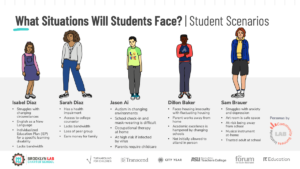Pearson Foundation Report Shows Retention Success
The Pearson Foundation teams up with former Secretary of State Colin Powell and Secretary for Education Arne Duncan to reveal Building a Grad Nation,” a study that takes account of successes in retention and preventing dropouts in our nation’s schools.
Below is the press release:
In Washington, DC today the Pearson Foundation and several business, government, education and child advocacy leaders release Building a Grad Nation: Progress and Challenge in Ending the High School Dropout Epidemic, a comprehensive report that reveals the first positive signs that America is making progress in reducing the number of students who drop out of high school. The report, produced by America’s Promise Alliance, Civic Enterprises and Johns Hopkins University’s Everyone Graduates Center, documents America’s progress in improving high school graduation rates—even in low-income, urban and rural school districts.
Building a Grad Nation and the plan of action it recommends are the result of the Pearson Foundation Dropout Prevention Roundtable, a summit of educational leaders convened in March 2010 specifically to address the dropout crisis and to identify innovative research and practice currently improving graduation rates in school districts across the United States. The Pearson Foundation also provided support for the research and documentation that informs the report’s key findings.
Specifically, Building a Grad Nation highlights:
- Innovative states and school districts that are successfully raising their high school graduation rates with scalable solutions, outlining clear measures that can be shared among school districts and classrooms across the nation to improve high school graduation rates.
- Improved student achievement in states and school districts resulting from a standard of excellence — a standard that includes the introduction of well-articulated goals and expectations from the state to the classroom; the deliberate challenge to all students of a more rigorous curriculum leading to a meaningful diploma based on college- and work-readiness; and the maintenance of a targeted approach sustained over time that provides extra supports to the school leaders, teachers and students who need them the most.
- Important progress on a range of reforms, policies, and practices at all levels—Initiatives that collectively are helping to ensure more students graduate from high school, ready for college and productive work.
Although these efforts are producing real results in school districts across the United States, the research presented today concludes that the pace is too slow to meet the national goal articulated by President Obama and U.S. Education Secretary Arne Duncan of a 90 percent high school graduation rate by 2020. To meet this goal, the report recommends that we calibrate our educational system to the greater demands of the 21st century through a Civic Marshall Plan deliberately designed to accelerate student achievement, high school graduation rates, and college- and career-readiness.
“Public schools are showing improvement thanks to reforms and other efforts that have been put in place, but we need to dramatically increase the pace of progress,” said Arne Duncan, U.S. Secretary of Education. “No principal, school board, teachers’ union or mayor can resolve a community’s dropout crisis alone. It takes everyone working together to make progress every year and build on success.”
“The research presented by America’s Promise Alliance, Civic Enterprises and Johns Hopkins University’s Everyone Graduates Center shows just how much has already been achieved as a result of everyone working together to tackle this essential issue,” said Pearson Foundation President Mark Nieker. “We have seen important gains in districts and states, even if, as the report makes clear, the need for progress still remains.”
Other findings of the report showcased schools that have shown dramatic gains:
- The biggest improvement in high school graduation rates among schools where dropout levels were highest – 216 of the 261 – occurred in the South.
o In Texas, the number of such schools dropped by 77. Georgia, Alabama and Tennessee all dropped by 20 or more schools.
o Tennessee and Texas saw an increase in graduation rates across all locales – cities, suburbs, towns and rural areas – indicating that improvement is possible in any type of community.
- Twenty-two states had improvement in graduation rates in urban areas, led by Texas, New York, Louisiana, Illinois, New Jersey, Florida, Wisconsin and Tennessee.
- Tennessee and New York led the nation by boosting graduation rates 15 and 10 percentage points, respectively.
- Ten additional states, including Alabama, had gains larger than the national average – ranging from about four to seven percentage points.
- More than half of all states – 29 in total – increased statewide graduation rates substantially from 2002 to 2008.
To view Building a Grad Nation and other programs and initiatives the Pearson Foundation supports, visit The Pearson Foundation website.
About the Pearson Foundation
The Pearson Foundation extends Pearson’s (NYSE: PSO) commitment to education by partnering with leading nonprofit, civic, and business organizations to provide financial, organizational, and publishing assistance across the globe. The Foundation aims to make a difference by sponsoring innovative educational programs and extending its educational expertise to help in classrooms and in local communities. More information on the Pearson Foundation can be found at www.pearsonfoundation.org.
Related articles
- Jumpstart’s Read for the Record Makes History, 2,057,513 Set New World Record for Annual Literacy Event (prweb.com)
- Tennessee no longer ‘dropout factory’ as high school graduation rate soars (knoxnews.com)
- Dropout Numbers Drop, But Are Still No Cause for Celebration (time.com)
- High School Graduation Rates See Small Boost, Report Says (time.com)







0 Comments
Leave a Comment
Your email address will not be published. All fields are required.